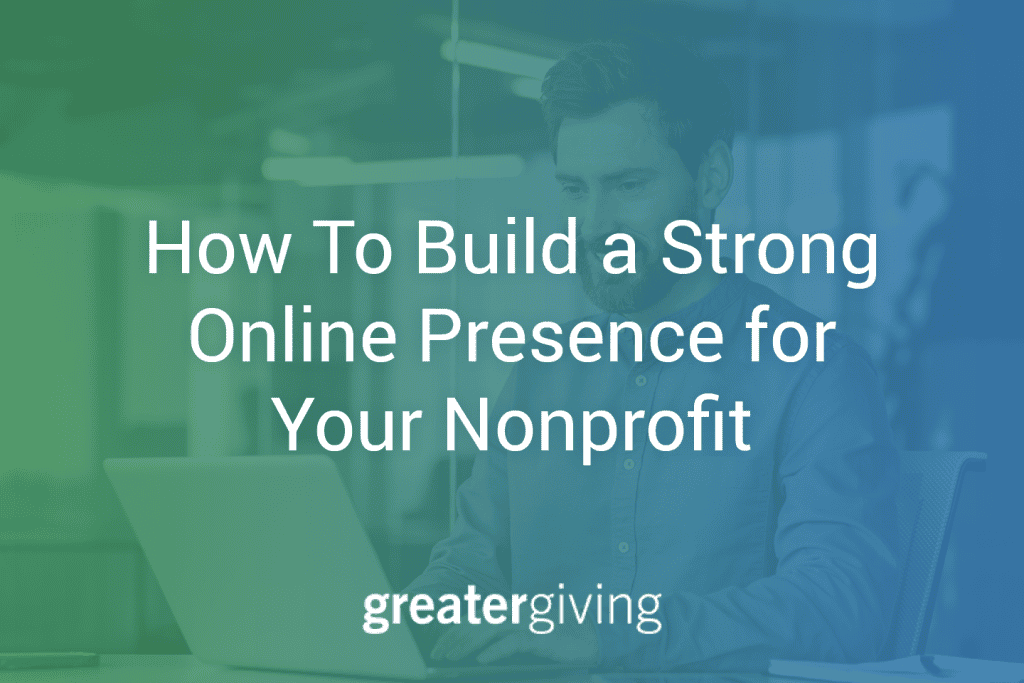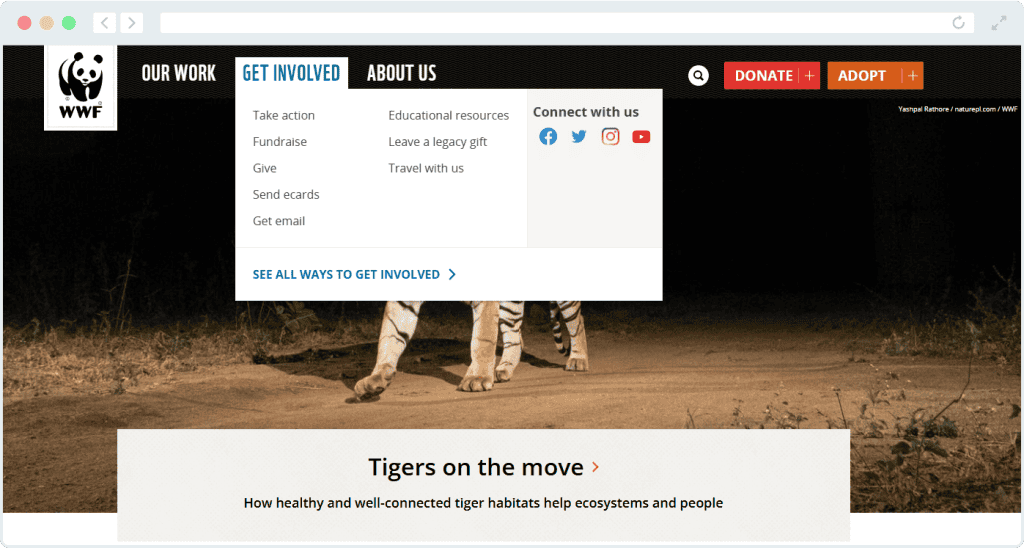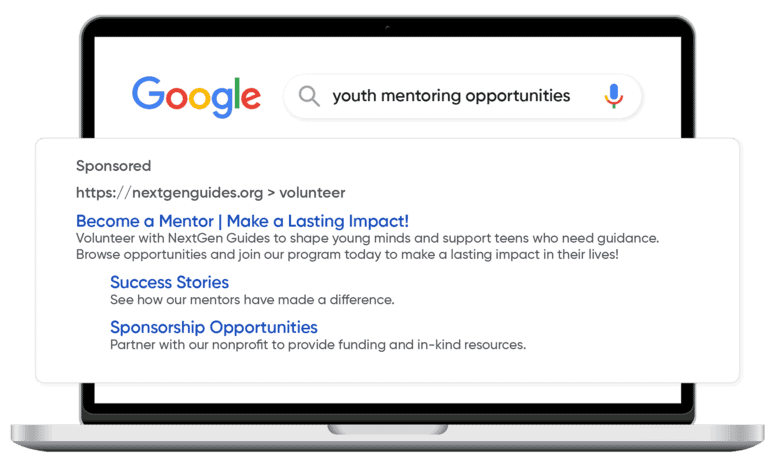
Building a strong online presence is one of the most exciting and impactful ways to amplify your nonprofit’s reach. The digital landscape is brimming with opportunities to connect with supporters, spread awareness, and raise funds. Plus, digital marketing is a cost-effective way to reach a wide audience with minimal overhead, making it accessible for nonprofits of all sizes.
Your nonprofit can use the online landscape to cultivate meaningful relationships with donors, volunteers, and beneficiaries.
From designing a user-friendly website to leveraging social media, these simple yet effective strategies will empower your organization to shine in the digital space.
When it comes to effective digital marketing for nonprofits, your website is a core asset. Your site’s content should effectively communicate your mission and provide clear pathways for involvement.
A few key pages to feature include:
- Homepage: An engaging overview that clearly communicates your nonprofit’s mission, key programs, and immediate calls to action (CTA) like donating or volunteering
- About Us: A page dedicated to explaining your nonprofit’s history, mission, values, and team
- Programs or Services: Detailed descriptions of your nonprofit’s core programs and their impact
- Ways to Give: Information on how visitors can contribute through volunteering, donating, attending events, or showing support in other ways
- Contact Us: A page with contact details, an inquiry form, and social media links to encourage site visitors to reach out
Feature these pages in your navigation menu to make them easy to find. Your menu should also include CTA buttons urging visitors to take one or two key actions. By monitoring your site data, you can understand which pages and CTAs drive engagement and optimize them for even greater impact.
Check out the World Wildlife Fund’s navigation menu:

It features main headings that turn into drop-down menus based on visitors’ goals. Then, it has two CTAs: one for donation opportunities and another that highlights an online store and adoption program. WWF shows how nonprofits can add their unique branding to CTAs with its “Adopt” CTA, allowing supporters to symbolically adopt a wild animal.
When creating your pages, keep search engine optimization (SEO) best practices in mind. This will ensure search engines like Google easily find your site. Getting Attention’s nonprofit SEO guide recommends creating high-quality, original content that addresses your audience’s interests. This content should include strategically placed keywords, be organized with header tags, and link to authoritative sources.
Promote Your Website With Google Ads.
Google Ads increase your website’s visibility by allowing you to promote involvement opportunities to specific audiences.
Google provides eligible nonprofits with up to $10,000 each month in ad credits. With these funds, you can create targeted campaigns that reach individuals based on location, interests, and search behaviors. That makes it incredibly easy to connect with your target audience.
Here’s how to make the most of Google Ads:
- Pick effective keywords. Consider what words a potential donor or beneficiary might search to find a nonprofit like yours. Enter those words or phrases into a tool like Google Keyword Planner to discover their monthly traffic, click-through rate, and other relevant metrics.
- Promote initiatives and involvement opportunities. The Google Ad Grant can help amplify content that advances your mission. You might promote your donation page, an upcoming event, or program information pages.
- Craft compelling ad copy. Focus on crafting concise copy that clearly communicates your nonprofit’s mission and urges supporters to take action. Use strong, action-oriented language to inspire clicks.
For inspiration, check out this example Google Ad that promotes a nonprofit’s mentorship opportunities:

The ad targets the keyword “youth mentoring opportunities” and promotes a relevant landing page. The strong copy emphasizes potential impact and urgency. The ad also leverages sitelink assets to add extra landing pages that provide social proof and sponsorship opportunities.
To maintain eligibility, Google Ad Grant recipients must follow compliance rules, such as using high-quality keywords and maintaining a 5% click-through rate. There’s a lot to keep up with, which is why many nonprofits outsource the work to Google Ad Grant agencies that understand how to craft strong, compliant ads.
Provide Opportunities for Online Giving.
Providing a way to donate online is essential for modern fundraising. Chances are, you already have a digital donation form on your website. Ensure it’s easy to use, secure, and provides multiple payment options (e.g., credit cards, PayPal, ACH direct deposit). To drive support, provide these donation opportunities to encourage donor engagement online:
- Online Events: Virtual events like online auctions provide an engaging way to raise funds and connect with supporters from anywhere. Encourage your donors to invite their friends and family to increase visibility.
- Recurring Giving Options: Automatic recurring donations help you build a stable funding base and give donors an easy way to commit to supporting your cause long-term.
- Social Media Fundraising: Take advantage of free fundraising tools on social media, like donate buttons on your Facebook Page or the Donate Sticker in Instagram Stories.
- Peer-to-Peer Fundraising: Encourage donors to raise funds on your behalf. This introduces your cause to new donor prospects and leverages the power of word-of-mouth marketing.
- Donation eCards: Allow donors to make a meaningful gift in exchange for a personalized eCard. They can send their purchased eCard to their loved ones, helping spread awareness of your cause. eCardWidget’s charity eCards guide highlights these Christmas eCards from the animal rescue organization One Tail at a Time:

Often, the best online fundraisers are those that involve supporters spreading the word about your cause, whether they’re soliciting donations for a peer-to-peer campaign or inviting others to events.
Build Awareness on Social Media.
Social media empowers your nonprofit to engage directly with its audience and increase visibility with minimal costs. When you post inspiring content, your followers will share it, connecting you with their networks.
Here are some actionable ways to use social media to build your nonprofit’s digital presence:
- Engage with your audience. Regularly interact with followers by responding to comments, asking questions, and reposting user-generated content. This helps build an active following.
- Keep up with trends. Join broader conversations and expand your reach by participating in popular trends or awareness days that align with your cause.
- Schedule your posts. Consistency is key in social media marketing. Marketing software enables you to schedule posts in advance, ensuring regular updates without the stress of daily management.
- Vary your content. Instead of just making repeated calls for donations, you might tell impactful stories about beneficiaries, post pictures from your events, or share educational content. You could also post appreciation shoutouts to thank donors and volunteers, giving them something to share on their profiles.
When people feel inspired by your social media posts, they’ll want to take action. Turn that motivation into support by linking to your website in your profile descriptions and providing links to specific campaign pages or educational blog posts when relevant.
Above all, remember that consistency and authenticity are key to developing an effective social media presence.
The internet is a goldmine of opportunities for nonprofits to grow their communities. By implementing these strategies, you can create a dynamic online presence that builds trust and loyalty.
Start small, prioritize the strategies that will work best for your nonprofit, and watch as your digital presence evolves into a powerful force for positive change.
